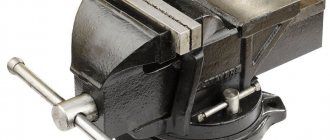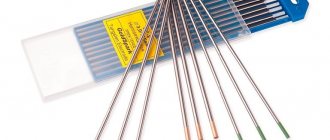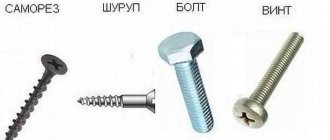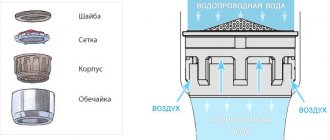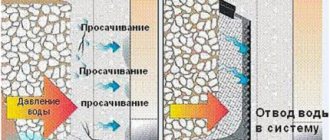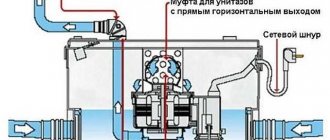Hammer
A simple tool in design, used by man since ancient times. The main property of a hammer is the ability to significantly increase the impact force and apply it accurately.
Hammer is translated into English as Hammer .
To carry out certain work, it is worth using hammers for the appropriate purpose. The right hammer affects not only the speed of work, but also the quality.
A hammer is a dangerous tool, so when working with it you must follow a number of safety rules:
- You shouldn't play with a hammer and fool around. In general, the most serious injuries occur in situations like this;
- Never work with a broken hammer or hammers whose head is not secured and may fall off;
- Never use a hammer that is chipped or cracked.
Sledgehammer
the largest type of hammer. The weight is used to drive concrete posts into the ground
The head of this tool is made of high-strength steel by forging followed by heat treatment in the form of hardening to the required hardness and can be in the shape of a parallelepiped or an ordinary hammer. By the way, the depth of the hardened layer after hardening reaches 30 mm. The handle has a larger diameter and length compared to previous models, which means two-handed operation.
The length of the handle is directly proportional to the weight of the working part of the sledgehammer: the higher it is, the longer the handle and can reach 120 cm, but is usually in the range of 80-90 cm. The cheapest sledgehammers have a wooden handle, but they can also be all-metal.
The hole into which the handle is inserted has a conical shape, and the handle itself is inserted from above and does not need to be wedged. This assembly method completely prevents the massive head part from slipping off. When working with a sledgehammer, you must be extremely careful, because it is considered a dangerous tool. There are several types of sledgehammers, but the most used are the blunt-nosed sledgehammer weighing 2-16 kg, longitudinal or pointed-nosed transverse, which weigh from 3 to 8 kg. The preferred handle option is a rubberized one; it is more expensive than a wooden one, but the tool will be securely held in your hands and dampen vibration during impacts.
Hammer device
The design of the hammer is simple. As a rule, it includes two components: a hammer head (head) and a handle.
Also, depending on the material of the hammer handle, an additional fastening element can be used. For example, for hammers with a wooden handle, wedges are additionally used in the design of the hammer.
The main element in the design of this tool is the hammer head. It comes in a variety of shapes, types and weights. For hammers with metal heads, they are made from special tool steel by forging or die stamping. In this case, the striker part of the head is hardened in water, and the side with the nail puller is hardened in oil. This technology makes it possible during future operation to ensure the strength of the hammer head and the plasticity of the nail puller. At the end, the product is opened with a special varnish to prevent corrosion.
The part of the hammer head that directly strikes is called the striker.
The firing pin can have a variety of shapes - flat, convex or jagged.
The flat shape of the striker is intended for driving (for example, nails). Convex shape - on hammers intended for striking another instrument. With a serrated striker surface - designed to prevent slipping.
In addition, the hammer head can vary in weight.
As for the handle, it can be made of different materials: wood, plastic and metal. The handle affects the ease of use of the hammer. It should be light in weight (relative to the head) and of appropriate length.
Construction store windows show a variety of hammer handles, and it is impossible to single out the most common material for handles.
Video on the topic
In conclusion, a few words about safety precautions. As you work, hold the hammer firmly by the end of its handle. Monitor the condition of the tool and do not put your hands near the impact site. Wear gloves and use pliers to hold nails in hard-to-reach areas. Naturally, some will dismiss the basic recommendations, but others will remember a couple of broken fingers and cases of a poorly secured working part flying out.
Hammer
- This is a hand tool used in metalworking, carpentry, carpentry and other works.
The hammer
is designed for hammering, breaking, straightening, bending, etc.
From this article you will learn what types and designs of hammers
.
Hammer design:
Any hammer
consists of
a head or body
and
handle
, connected to each other through a hole in the body and a wedge driven into the handle.
The body consists of the part that is struck - the striker
, and
tail or toe
, the toe can have a different shape. The body is usually steel, but can be made of copper, lead, wood, or rubber.
The handle can also be made of various materials, most often wood, plastic, and metal.
Types of hammers.
Types of hammers
, their dimensions and weight are determined by GOST 11042-90.
Let's look at the main types of hammers
:
– has a round or square striker and a wedge-shaped toe. A carpenter's hammer with a square head is intended for working on wood, and with a round one for working with sheet iron. The weight of the plumbing hammer body is 250-800 g.
Carpenter's hammer - differs from a metalworker's hammer in the form of a nail puller for removing nails. The weight of the carpenter's hammer body is 600-750g.
- the largest hammer, used for cutting out partitions, recesses, removing old tiles, etc. The body weight of such a hammer is 1-1.5 kg.
Wallpaper hammer - used for hammering small nails, distinguished by its small body and thin handle. The body weight of such a hammer is 100-250 g.
There are also hammers with bodies made of wood, rubber, lead, copper. Such hammers are used for furniture assembly, critical work with pressure-sensitive parts, and when working in explosive and fire hazardous areas.
Types of hammers
There are a very large number of types of hammers in terms of their diversity, purpose and application. We will omit such types of hammers as kitchen, medical, shoe and the like, and will try to mention all types of hammers used in construction.
Locksmith's hammer
This is a classic hammer in shape, with a flat head on one side of the head and a wedge-shaped head on the other. The wedge-shaped side is called the spout.
This type of hammer is used almost everywhere and has the largest range of sizes in terms of weight, from 200 grams to over 1 kg.
Lightweight small hammers are used for driving small nails. They are used when installing wooden glazing beads, when working with lining (lining nails) and small-sized clamps.
Heavier hammers are used almost everywhere: in everyday life, for bending metal, driving nails, in a variety of jobs.
Due to its practicality, this is the most common type of hammer.
Handles
In modern models, these hammer parts are made of plastic, polyurethane, and fiberglass materials. However, according to the experience of professionals, a wooden handle is still the best and most popular.
Pegs can be driven into the wood to make the grip on the striker stronger.
In addition, if the handle breaks, you can make it yourself.
Fiberglass is also popular today. It is considered a type of fiberglass. This material contains more than 70% fiberglass. Also contains polyester resins. This material is characterized by very high durability and resistance.
Among the main advantages of fiberglass is strength. It is 9 times higher than that of plastic, and also 4 times higher than that of aluminum. Handles for hammers made from it are not deformed.
Hammer with nail puller
This hammer can be called a roofing or carpenter's hammer.
Its uniqueness is that it has a round convex striker shape, and on the other side there is a nail puller. Such features of this hammer create convenience when working with nails, which is in demand in roofing and carpentry work.
Very convenient and practical when installing sheathing and bitumen shingles.
In size they are medium weights 500-600 grams.
Suitable for driving nails up to 150 mm in size.
It is worth noting that low-quality hammers of this type are very common on sale. They are cheap in price. They are light in weight and have a poor connection to the head. As a result, they break literally after the second blow or during the first attempt to pull out the nail.
But you shouldn’t overuse the nail puller even with high-quality hammers. They can also break under heavy loads. This applies to pulling out nails larger than 150 mm for ordinary construction (glossy) nails and 100 mm for rough or screw nails.
Rating
Each type of hammer has products that can be called the best. When evaluating a tool, technical characteristics, cost and performance properties are taken into account.
Sledgehammers
KAPRIOL 12301
Easy-to-use steel sledgehammer with fiberglass handle. Product weight 3 kg. Handle length – 90 cm. The connection between the head and the handle is epoxy. The KAPRIOL firing pin has a square shape, ensuring accuracy of impact. Manufacturer's warranty – 6 months.
Advantages:
The disadvantages include the high price of the tool.
FIT 45232
The Canadian brand has a distinctive yellow and black handle. Produced in China. Refers to a professional instrument. The length of the fiberglass handle is 800 cm. The firing pin is made of high-strength steel. It has a square shape. Product weight 4 kg.
Advantages:
- Weight.
- Reliability.
The main disadvantage is the high cost.
Locksmith
Inforce 59035
The tool has a very thoughtful design. Product weight – 500 g. The handle is equipped with a fiberglass coating. Has indentations for fingers. howl coating. The hardness of the striker is 10% higher than the requirements of the DIN standard. The method of fastening the elements is injection gluing with epoxy resin.
Advantages:
- Comfortable rubberized handle.
- Increased reliability.
The main disadvantage is insufficient weight for certain types of work.
Delo Techniki 315100 DT/24/6
A weighted hammer that can be used to hammer nails very quickly. 45 steel is used to make the striker. The handle has a rubberized design. This ensures work safety.
Advantages:
- Low cost.
- Reliability of the design.
No deficiencies identified.
Pickaxes
BISON MASTER 2015-05_z01
The hammer cannot be called a full-fledged pickaxe due to its low weight. Product weight 500 g. The firing pin has increased strength. Made of steel 55. The handle is made of wood, which is considered a minus of the product.
Advantages:
The disadvantage is the material used to make the handle.
Sturm 1010-05-600
The hammer is equipped with a striker made of high-strength steel. Pickaxe weight 600 g. The handle is two-component. The surface of the steel base is covered with a fiberglass lining. There are three finger grooves. This improves safety and makes the handle more comfortable.
Advantages:
- Comfortable handle.
- Long service life.
The disadvantage is the high cost.
Carpentry
Stanley FMHT1-51276
The hammer head is shaped like a straight nailer. It is equipped with a striker with a hardened surface and a protective coating. The vibration of the tool during operation is softened thanks to a special lining on the handle.
Advantages:
The disadvantage of the tool is its high cost.
NEO 25-000
The hammer is made of a monolithic steel billet. This provides the structure with increased strength. Product weight 450 g. The handle is two-component. A special coating prevents your hand from slipping.
Advantages:
- Long service life.
- Light weight.
- Ease of use.
- Increased strength.
A disadvantage is considered to be poorly adjusted instrument balancing.
Straightening
ONNESWAY M10110
The hammer is very popular among car mechanics. The tool head has a rounded striker. The second side is made in the shape of a peak. The handle is extended. The design allows you to perform a wide range of work.
Advantages:
The main disadvantage is the high price.
KING TONY 7842-28
Multifunctional model. The hammer is used not only by bodybuilders, but also by installers, mechanics and carpenters. Walnut wood is used to make the handle. The tool is lightweight.
Advantages:
- Ease of use.
- Wide functionality.
The big minus is the rapid wear of the striker.
Roofer's hammer
In addition to the roofing hammer, it also received popular names: sharp-toothed hammer, fang hammer, sharp-nosed hammer.
This hammer combines the functionality necessary to carry out common roofing work.
It has a serrated striker that prevents slipping when hitting the nail.
The end part of the hammer head on the striker side is equipped with a groove for inserting a nail, which is convenient when it is not possible to hold the nail with your second hand:
The groove is designed to place a nail without holding it with your second hand. It has the contours of a nail and has a magnet in it that prevents the nail from falling out.
On the side of the nail puller there is a sharp nose - this is an element from a classic slate hammer.
The weight of the hammer is 500-700 grams, which is suitable for driving nails measuring 35-150 mm.
Sax
Another type of roofing hammer.
This hammer belongs to a specific type of tool and is used only for specialized work.
This hammer is designed and used specifically for the installation of slate roofing, piece tiles and slate.
The sharp nose of the hammer serves as a punch. There is also a nail puller on the hammer. The hammer handle is rounded, which allows you to conveniently use all the functionality of the hammer.
Roofing hammer for slate roofing
A hammer designed for working with slate roofing. On one side of the hammer head there is a serrated head, and on the other there is a hatchet with a nail puller:
A hatchet with a hammer is needed to trim the edges of slate tiles, which must be done using technology to remove traces of factory processing of slate.
Slate roof hammers come in a wide variety of shapes and sizes.
Mallets
Mallets are often wooden and rubber hammers that are used in cases where damage to the surface of the material being worked must be prevented.
The range of these hammers is simply huge. The variety in size and type of material is very large.
Mallets are used when working with fragile materials, as well as in order to avoid damage to the surface of a part, product or tool in contact with the striker.
Professional wooden mallets are made from larch.
A rubber hammer is mainly used in laying paving slabs and in car body repairs.
Straightening hammer
Also, this hammer is called a lyapka .
This is a special professional tool for working with thin sheet metal and tin.
Laps come in different sizes and shapes. Selected for specific tasks.
Pick
The pickaxe is considered a mason's hammer.
The hammer is used to knock down the brick during laying, and with the opposite side, in the form of a spatula, the brick is hammered to the required dimensions.
The pick is also widely used for removing plaster and cleaning used bricks.
Characteristics, types and purpose of the tool
Hammers vary in shape, weight and material. Summarized data on tool modifications are presented in the following table:
| Name | Dimensions | Average weight | Application |
| Hammer | The height of the hammer in mm depends on the weight of the hammer and ranges from 1830 mm to 3500 mm | From 0.5 kg to 9 kg, in large forges - from 40 to 100 kg, in steel and iron factories up to 50 tons | For striking when breaking stones, forging metals |
| Locksmith's hammer | Standard design | 300-500 g – for home and household use, more massive – 2 kg | Working with metal products, striking a chopping tool or hitting a core |
| Carpenter's hammer | Handle length – from 20-30 cm | 250-450 gr | For driving or removing nails in carpentry or carpentry |
| Mallet (wooden hammer) | 130×90×60 mm | 300 gr | Assembly, dismantling, molding of materials and structures |
| Sledgehammer | Volumetric tool | From 3 to 15 kg | Dismantling and installation work (breaking walls, driving posts and pipes into the ground) |
| Fizdel's Hammer | The impact part of the hammer ends with a steel ball Ø17.5 mm | 250 gr | Testing the strength of concrete |
| Kashkarov's hammer | 253×40×53 mm | 1.5 kg | Testing the compressive strength of concrete using the impact method |
| rock hammer | 290 mm | 600 gr | In rock climbing, mountaineering, speleology, for setting and removing rock pitons, processing the edges of rock ledges, punching bolt holes |
| Jackhammer | Average shank size Ø 24 mm, length 70 mm | From 3 to 30 kg | Cutting down openings and niches in walls, dismantling brick and concrete permanent structures, destroying frozen or heavy soil, removing old road surfaces |
| Roofing hammers | 300×120×50 mm | 0.6 - 0.75 kg | For roofing work, leveling and sealing seams |
Habero 600 IH 500
This product is also suitable for a wide variety of plumbing jobs.
The material used is steel. The head is covered with black varnish, the striker shape is square.
The chrome vanadium alloy head has high hardness and does not flatten. By the way, the price for such a mechanic’s hammer is more than affordable for a home craftsman (from 200 rubles).
The market also offers other products. Today, the range of metalworking hammers is unusually wide. There are a lot of tools depending on needs, weight, materials, functionality. The main thing when choosing is the quality of materials, ergonomics and durability.


